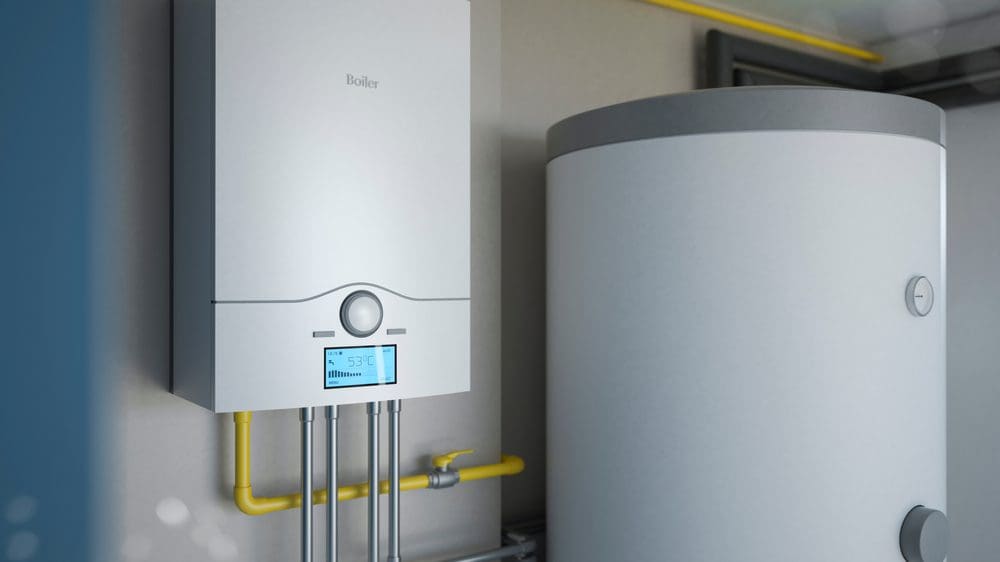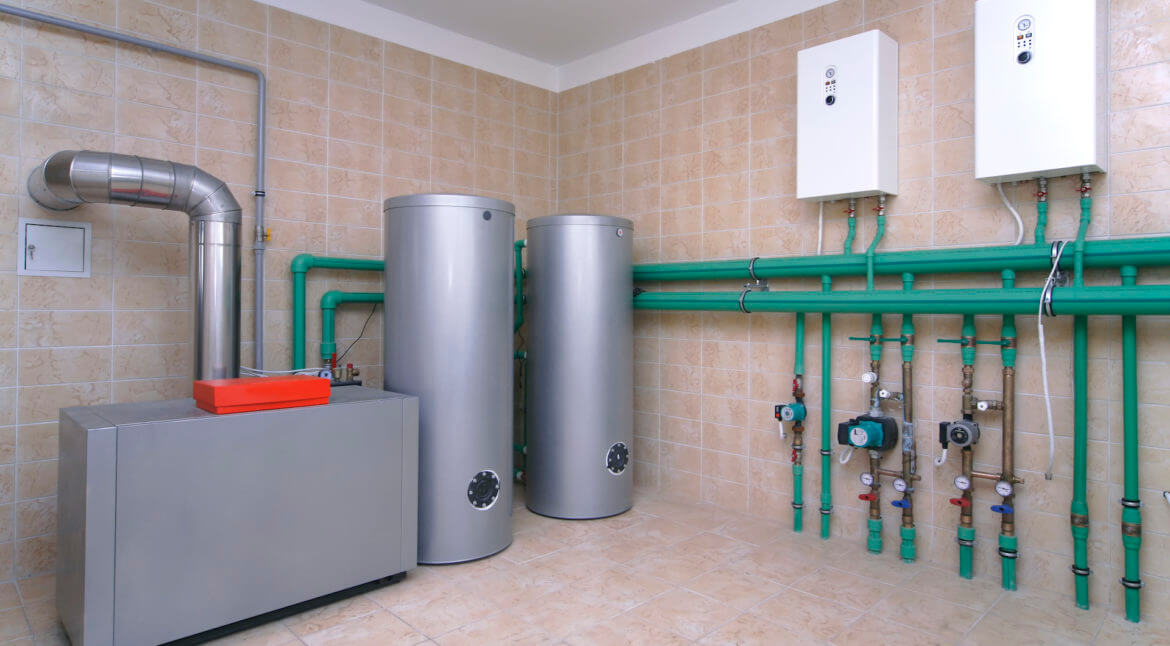A boiler might not be the flashiest thing in your home, but it’s the workhorse keeping your space warm and your showers hot. If you’ve ever wondered what one actually looks like, you’re not alone.
This guide breaks down the appearance, common features, and variations so you can spot and understand your system with ease.
What does a boiler look like?
A boiler looks like a solid rectangular metal box with a control panel, pipes connected in and out, and sometimes a flue venting outside.
Key Takeaway
- Boilers are solid metal heating units, usually boxy in shape.
- They have a control panel, pipes running in and out, and often a flue leading outside.
- Different types, combi, system, regular, electric, oil, look slightly different but share core features.
- Boilers are usually found in basements, utility rooms, or kitchen cupboards.
- Recognising your boiler helps with spotting problems and communicating with technicians.
What Is a Boiler?

A boiler is basically your home’s heat engine. Instead of burning fuel just for flames, it converts that energy into hot water or steam. That heat then flows through radiators, baseboards, or underfloor pipes to keep your place cosy.
You’ll usually spot a boiler as a solid metal unit, often boxy, with pipes snaking in and out. Some are compact wall-mounted setups, others are larger floor units that mean business.
Think of it as the unsung hero in the basement or utility room. It doesn’t look flashy, but without it, winter would feel less hot cocoa and more survival camp. If you’ve ever wondered how do you diagnose a boiler problem, this hidden workhorse is usually where the answer starts.
Why Knowing What a Boiler Looks Like Matters
If you don’t know what your boiler looks like, spotting issues is nearly impossible. Recognising it helps you notice leaks, rust, or weird noises before they turn into expensive disasters.
It also makes life easier when you’re talking to a technician. Instead of fumbling through vague descriptions, you can point out the exact part causing trouble.
Plus, knowing your boiler isn’t just practical, it’s empowering. You’re not left guessing when someone mentions “the cylinder” or “the flue.” You’ve got the visual context, so you stay in control of your home setup.
General Appearance of a Boiler
A boiler doesn’t look like a futuristic gadget, it’s more like a solid metal box that means business. Most modern residential boilers are sleek rectangles, usually in white, grey, or black finishes. Think “minimalist fridge but smaller,” tucked against a wall instead of standing centre stage in your kitchen.
On the front, you’ll spot a simple control panel with buttons, knobs, or a small digital screen. That’s where you adjust heat, check pressure, or see error codes if it’s acting up. It’s designed to be user-friendly, so you won’t need an engineering degree to read it.
Pipes usually sprout from the top, sides, or bottom, carrying water or gas in and out. Some boilers are wall-mounted to save space, while larger models stand on the floor like a chunky cabinet.
A boiler’s design is all about function, not flash. It quietly fits into basements, utility rooms, or tucked-away corners, often going unnoticed until the heat kicks in. And when something goes wrong, having access to professional boiler repair makes all the difference in keeping that comfort reliable.
Types of Boilers and How They Look
Combi Boilers
These are the city slickers of the boiler world. Compact, wall-mounted, and usually tucked away in a kitchen cupboard.
A combi doesn’t need a water tank, so you’ll spot just one neat unit with a digital display and a couple of pipes running beneath. Think of it as the slim laptop version of heating—small, efficient, and all-in-one.
System Boilers
System boilers are bulkier than combis but still fairly modern looking. You’ll see the main unit, often a boxy white case mounted on a wall, paired with a separate hot water cylinder.
The cylinder usually hides in an airing cupboard, looking like a tall metal barrel. Together, they take up more space but flex harder on big households with high hot water demand.
Regular (Conventional) Boilers
These are the old-school OGs. They need both a hot water cylinder and a cold water storage tank, usually parked in the loft. The main boiler looks like a chunky white box, but the real giveaway is the maze of tanks and pipes connected to it.
If you see a set-up that looks more like a plumbing jungle than a single unit, that’s a regular boiler in action.
Electric Boilers
Electric models are the minimalist cousins. They often look like oversized circuit breaker panels or sleek metal boxes. No flue sticking out the wall, no loud burner.
They’re usually slimmer than gas boilers, making them easy to slide into small utility rooms or under counters. Clean, quiet, and a bit futuristic.
Oil Boilers
Oil boilers tend to look like beefed-up regular boilers. The unit itself is a solid rectangular box, usually bigger than a gas boiler, and it’s paired with a separate oil storage tank outside.
That tank? It looks like a giant plastic or steel container, usually green or black, sitting in your yard. Not the prettiest, but it’s the muscle car of heating—powerful and reliable.
Floor-Standing vs. Wall-Mounted
Beyond type, boilers also split by where they sit. Wall-mounted models are slim and modern, blending into kitchens like a built-in microwave.
Floor-standing ones are the heavyweights—big, square, and planted firmly on the ground, usually in basements or utility rooms, where homeowners often also need services like boiler repair in North Providence.
Key Features That Make a Boiler Recognisable
Spotting a boiler isn’t rocket science once you know the signs. They’re not flashy, but a few design cues make them easy to pick out in a room.
Boxy Shape: Most boilers look like rectangular metal boxes, kind of like a mini fridge without the door handle. Wall-hung ones are slimmer, while floor models have a bulkier vibe. Either way, the squared-off design is the giveaway.
Control Panel: On the front, you’ll usually find a control panel with buttons, dials, or a digital display. That’s where you tweak the temperature, reset the system, or check for error codes. Think of it as the boiler’s dashboard.
Pipes Everywhere: Look at the top or bottom, and you’ll see pipes branching out. These handle water supply, heating flow, and gas or oil feed. If you spot a cluster of copper or steel pipes leading in and out of the unit, you’re staring at a boiler.
Flue or Vent: Every boiler needs a way to expel exhaust gases. That’s usually a round flue pipe coming out of the back or top, often leading outside through the wall or roof. It’s not glamorous, but it’s the telltale sign of a working system.
Size and Sound: Boilers are quiet but not silent. A faint hum or gentle whoosh when it fires up is normal. Size-wise, they’re compact compared to furnaces, making them blend better into kitchens, utility rooms, or basements.
Bottom line: if you spot a metal box with a control panel, pipes running in and out, and maybe a flue venting outside, that’s your boiler. And if it ever stops working as it should, professional boiler repair in Barrington is just what you’ll need.
Where Boilers Are Usually Found in a House
Boilers aren’t designed to be part of your living-room décor, so they’re typically tucked out of sight. Most homeowners keep them in the basement, where they remain hidden but still easy to access for service, especially when troubleshooting issues like why is my furnace blowing cold air.
If you don’t have a basement, check spots like utility rooms, garages, or even the laundry area. Builders often tuck systems away where they won’t disrupt your daily flow, and knowing these hiding places can help when you need quick access for things like boiler repair in Riverside.
In smaller homes or apartments, boilers are often tucked into a kitchen cupboard or hallway closet. While style matters, you also want quick access—especially if you ever find yourself wondering why is my boiler not heating water. The trick is to keep it hidden yet easy enough to reach when maintenance calls.
Common Misconceptions About Boiler Appearance

A lot of people picture boilers as giant, rattling tanks straight out of a horror movie basement. Truth is, most modern units are sleek, compact, and more wall-mounted box than Frankenstein contraption.
Another myth? That all boilers look the same. Gas, oil, steam, and combi systems each come with their own setup. Some look like a slim fridge, others resemble a small cabinet, and the installation process varies too, people often ask how long does a boiler installation take before choosing a system.
Many also confuse boilers with water heaters. A boiler heats your entire space, not just your shower. Once you know the differences, spotting one at home or in a shop becomes easier—and if you ever need reliable boiler repair in Woonsocket, you’ll know exactly what system you’re dealing with.
Frequently Asked Questions
1. Do all boilers look the same?
Not really. Some are tall cylinders, others are box-shaped units that sit on a wall. The design depends on the type and size of the system.
2. How can I tell if something in my basement is a boiler?
Check for pipes running in and out, usually with gauges and a pressure dial. If it’s feeding heat to radiators, you’ve found your boiler.
3. Is a boiler dangerous to touch?
When it’s running, the outside can get hot. Best move? Don’t lean on it like it’s furniture. Stick to controls, not the casing.
Conclusion
A boiler isn’t some mystery box—it’s basically a metal tank with pipes, valves, and a control panel. Once you’ve seen one, you’ll recognise the look anywhere.
The key is knowing whether it’s the right size, style, and system for your space. If yours looks ancient or out of place, it’s probably time to swap it for a high-efficiency model.